While I was happy to be working on Commander over at Dear Azami, I still had an interest in writing about other formats from time to time, and you can’t exactly transition a column about Commander over to Legacy or Modern on any given week… especially when that column includes reader input as an integral part of it, as Dear Azami does. By now the surprise has been aired that I’ve stepped away from the column in order to try and finish off the book I’m writing, and the next few months will be critical for that, but I am still hoping that you’ll see me again from time to time since I’ve still got a few things I’m hoping to write about.
My last two non-Dear Azami columns were about Kiki-Pod in Modern; I said I would play that deck until they pried it from my cold dead hands, and through the bannings at the start of the year they’ve done exactly that. This saw me spending the past few months in search of a new deck to call my own, and after a lot of abortive attempts to put Wild Nacatl and Delver of Secrets together and some fumbling around with Living End and Splinter Twin (but not together, which is apparently maybe a thing), I seem to have found what I was looking for.
This deck has strange parents. I know far too well that a great deck can go winless without it saying much about the deck itself; one of my StarCityGames Standard Open Top 8s came when I went 9-1 with Mono-Green Elves, but what wasn’t really mentioned was how the exact same 75 cards went 0-4 just two days before at a small Standard tournament where I was cramming in some last-minute playtesting. An entire tournament without a single win feels worse than it actually is, and thus I know that throwing out a good deck after one bad showing is a mistake we’re somewhat pre-conditioned to make. The plural of anecdote is not data, but we’re wired to feel that way.
My initial tinkering after Birthing Pod was banned was basically just me waiting for the results of the upcoming Modern Pro Tour, knowing that would be very informative about how the format was shaking out in its latest iteration, where one deck in particular caught my eye. I didn’t know particularly what I wanted to do with this point of information once I saw it, but it was a very different take on what is possible and what is worthwhile, so I perked up and paid attention to it:
Creatures (8)
Planeswalkers (3)
Lands (19)
Spells (30)

Modern, like Legacy, has a deep card-pool of powerful things you can do and thus it is not prone to shifting around very much just in general principle. We saw big swings in the format after Treasure Cruise was printed, though, and Chapin’s deck is an excellent example of the fact that the right cards can shift things – incredibly undercosted creatures are worth enabling, and big Delve creatures require us to pay attention. But just a few weeks after that Pro Tour, Gerard Fabiano shook things up a bit too, and given how much I love playing Thragtusk in Modern I had to pay attention here as well:
Creatures (11)
Planeswalkers (3)
Lands (24)
Spells (22)

It’s hard to argue with success, but after only a few games it was clear to me that this was a very Gerard deck – he’s well-known for playing a pile of cards he likes that has been carefully tailored to his playstyle, and picking up his deck without porting over his entire decision-making process as well wasn’t going to yield me the same results. Still, both of these decks caused me to think about Modern a bit differently – of course Ashiok might just be awesome when playing both with and against Tarmogoyfs, and Jace, Architect of Thought is undeniably great if the format is as much about Lingering Souls as it appears to be. There was even some overlap between the two decks, though they were taking radically different approaches at winning the game – Serum Visions and Tasigur led them down very different paths, but both were undeniably present.
I started with a simple question:

Is Gurmag Angler actually good?
It takes committing to a fairly narrow framework in order to get it online, as it only really starts being good once you’re spending just one or two mana for it. At three mana you can get a 4/4 with upsides and could shoot for Knight of the Reliquary if you wanted to get a 5/5 with the potential to get even bigger, so Angler’s high quality is inversely proportional to its casting cost. You don’t have to go very far down that particular rabbit hole to start making Angler reasonable – people already play a lot of fetchlands in Modern because they’re the key to great mana, Serum Visions is incredibly solid anyway, and Thought Scour is already strong when you are playing Snapcaster Mage but in the context of the Delve mechanic it might as well say “Dark Ritual, draw a card.” Then you start adding the zero-cost cantrips and you can get part of the way there by cutting your manabase back, as Chapin did, so his basic frame for maximizing Angler was well-tuned. The question I had to ask myself, looking at Patrick’s deck and then at Gerard’s, was simply this:


Is Angler better than Tarmogoyf?
Once you start adding Mishra’s Bauble to maximize your quick Delve creatures, you have to realize that Goyf would probably love the Bauble too – you can get land, instant, and sorcery just from playing early spells, and creature is easy to get in there too either out of your own graveyard or your opponent’s, but artifact, enchantment, tribal and planeswalker usually take a lot more finagling than Mishra’s Bauble asks for. My starting point was basically to marry Chapin’s deck to Gerard’s, abandoning white mana in favor of green and not worrying too much about it because Abrupt Decay is very nearly as good as Path to Exile even in a deck such as this one where the jump from one to two is way more than double the effective cost of a spell. This meant getting rid of a lot of the pure Gerard cards and even the basic premise of Gerard’s deck, which is more of a control shell – and we even have to take out the thing that had first caught my attention because Thragtusk is literally impossible to ever afford if we’re aiming to operate off of a smaller number of lands. Maybe I could still get behind a couple of three-drops, and I tried out single copies of Cryptic Command and Jace, Architect of Thought to see how good they were in this shell, but I just wanted to lean on Goyf + Tasigur, Inquisition + Stubborn Denial, and as many cantrips and cheap removal spells as it took to make those things work out.
It was a decent shell, and it reminded me a lot of playing Legacy – playing aggressive Tarmogoyf decks with Brainstorm + fetchlands gives you a lot of options at every point in the game and helps make sure you see a lot of cards, so every slot matters a ton and so does every mana spent, plus you have to be super on top of what’s going on because there are a huge number of decisions compressed into those first few turns. Each slot mattered so much that it took me weeks of trying things out and shifting around just three or four cards at a time in order to get a feel for where the right balance lay, especially in the sideboard – despite the fact that no card in the sideboard is present as more than a two-of. While those playtesting and deck-tuning sessions were greatly interesting to me, I doubt they’re as interesting to you, so let’s get right to the decklist and talk about how everything works:
Creatures (15)
Lands (19)
Spells (26)

Everything here is all about interactions. We’ve seen Delver + Tarmogoyf decks before in Modern without them really panning out, so the question comes down to what makes this one special and the answer comes from marrying Chapin’s delve shell to the spell-happy nature of a Delver of Secrets deck. Up until the recent spate of Grixis decks we now see or exceptional times such as Treasure Cruise being legal, Delver hasn’t really caught on much in Modern because there aren’t that many ways to preferentially select the top card of your deck once you’ve cast it – with Ponder and Preordain banned, you have Serum Visions and that’s it, so most of the cards that would really have made a Delver deck hum got banned so they don’t make the combo decks hum instead. There’s another interaction if we want it though, it just happens to be that no one seemed to consider it to really be worth playing before, so something had to change in order for it to make the cut – and that something is the power of the Delve mechanic.
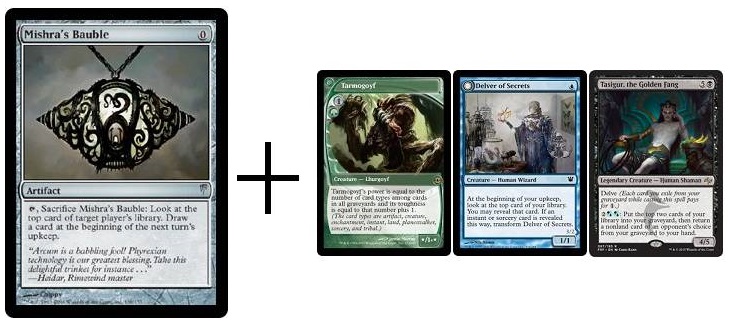
Mishra’s Bauble has been around for a while without really ever getting attention, and prior to Chapin’s deck at the Pro Tour I don’t think it had ever been played at a premier event before. Urza’s Bauble is a comparable card that only found a home when something else broken came along – until you could build a Necropotence deck with Yawgmoth’s Will in it, Urza’s Bauble was a quiet curiosity that didn’t go anywhere interesting. Mishra’s Bauble is likely much better than Urza’s Bauble is – being able to look at the top card of either player’s deck is considerably more valuable than looking at a random card in your opponent’s hand – but still, something really has to put you in the market for that kind of an effect, because the half-turn wait of a “slow-trip” is a real cost, as is not knowing what the actual card in your hand is when you see a Bauble in your starting grip.
As mentioned above, Tarmogoyf probably loves a Bauble – you can get to 4/5 pretty easily against basically any opponent just by playing a normal game of Magic, but to grow your Tarmogoyf even bigger than that tends to take some work. With no mana invested and at no cost of a card, drawing a single copy of Mishra’s Bauble gives your Tarmogoyfs +1/+1, and that’s a pretty worthwhile benefit. It’s not worth warping your deck around just to get this benefit because you can only play four Tarmogoyfs and the opportunity costs are real, but when there are multiple cards benefitting from Baubling in this way, your Tarmogoyfs become really happy and tend to battle as two-mana 5/6’s.
Tasigur definitely loves a Bauble, as Chapin demonstrated – you can play Tasigur on turn two pretty consistently just by playing your cards in a deck like this. Two mana plus two fetchlands leaves just two more cards needed just to fuel Delve, and it’s reasonable to think your first point of mana might be spent playing a spell like Serum Visions or Inquisition of Kozilek. That means you just need to find one more card somewhere, and you can use Thought Scour to get there or any zero-mana card – Bauble or Gitaxian Probe both work, but two life is an even more real cost than the half-turn delay on Bauble plus sorcery is less important to your Goyfs even if it does flip a Delvers when you reveal it and has a strong interaction with Snapcaster Mages. But you can’t just drop two life in order to fuel Tasigur without accounting for that in Tasigur’s cost-benefit analysis, and when you’re playing the full set of Inquisitions anyway, the “look at your opponent’s hand” portion of Gitaxian Probe is much less relevant.
But where the Bauble really changes what we’re used to thinking of as possible is with Delver of Secrets. Ponder and Preordain are both banned, so we’re used to only having Serum Visions to help flip our Delvers and thus we’re used to thinking of Delver as powerful but inconsistent in this format – at least when we’re not Cruising. Mishra’s Bauble can actually help you flip a Delver though, and not just later in the game – the turn-one play of land, Delver, Bauble actually doubles your chance of flipping Delver of Secrets in time for your first attack. Just pass the turn and target yourself with the Bauble during your opponent’s turn and you’ll know what your top card is just in time to decide how you’re stacking triggers during your upkeep. If the top card will flip your Delver, put “draw a card from Bauble” on the stack and then “Delver looks at your top card,” reveal the appropriate spell to transform into an Insectile Aberration and draw off the Bauble. If the top card won’t flip Delver, stack your triggers in the opposite order and you’ll draw off the top of your deck before Delver asks to see the top card, giving you a second chance at blind-flipping your Delver. It’s not that much card selection – Ponder would be way better at this – but it’s enough to make a dent especially if you’re inclined to play the Bauble anyway to enable other cards.
There is admittedly some tension between Tarmogoyf, Snapcaster Mage and Tasigur, but we’re very good at stocking our graveyard so we will generally be able to accommodate all of them at once – and most of our opponents won’t be able to remove card types from their graveyard, so we only really have to worry about small portions of our graveyard while casting Delve spells. More thought is required before potentially walking Tasigur into a Remand, but managing the size and contents of our graveyard is not that hard of a bookkeeping chore thanks to the setup cards providing plenty of fuel.
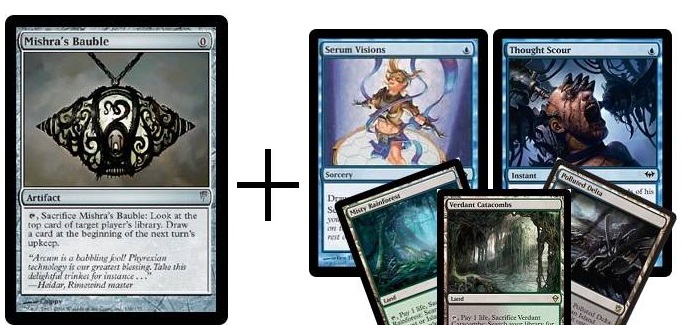
Selection is important to low-land-count blue decks, and here is where the fact that Bauble costs zero mana starts to compress things like we’re used to seeing more in Legacy than in Modern. Fetchlands + Bauble raise an interesting point: if the top card is worth drawing, which land do you play this turn? Being able to clear the top card if you don’t want to draw it is great, and while we wouldn’t want to spend either a mana or a card in order to do that, Bauble asks for neither – just for a half-turn delay on drawing a replacement.
Serum Visions and Thought Scour also like knowing what your top card is – if there’s something good, you can afford to wait half a turn cycle before casting Thought Scour, and if the top card is not really useful to you just go ahead and mill past it. Serum Visions takes more work, but when you start adding the ability to touch your deck to it via other cards, it gets even better than it already is. Top card’s no good? Fetch before you Serum Visions and try again, then Scry into something good for the Bauble’s replacement effect to draw you into.
Fetchlands and Thought Scour are also good with Delver of Secrets’ ability to show you the card you are about to draw; if you don’t need what the top of your deck has on offer, either can change the top card of your deck before you draw your card for the turn. Between the different portions of the deck, there’s just a ton of card selection going on, letting your cardboard just work harder because you’re going to draw better than an opponent who isn’t constantly touching the top of their deck like you are. It also means that these interlocking functionalities let us get away with playing far fewer lands than anyone else, so we draw more gas on average than our opponents.
This deck is down to nineteen lands, and that’s actually a little bit heavy on the mana – a Temur version of this basic shell recently made a splash in Worcester playing just seventeen lands, and three of those were Forest, Mountain and Stomping Ground, leaving just fourteen blue sources to get things started. We need a bunch of blue mana but don’t want to feel like we’re flooding out when we draw too many lands, which is why two of them are Creeping Tar Pits to give us something more spell-like to do with our mana if we flood some. I think the deck would actually be happy to be down to eighteen lands, but the costs there are very real: since we still need as much blue mana as we can get our hands on in order to make everything work, the real price of shaving one more land is to cut Forest + Swamp and add Overgrown Tomb. Burn decks are a thing, as are just generally-aggressive decks, and so is Blood Moon. Being able to fetch basics – and being able to operate off of Island, Forest, Swamp – is very important when we can’t start the game at fourteen because we fetched into two shocklands.
Of the three basics, it’s actually the Island that is least important to us – we’d prefer to try and operate off of Watery Grave + Forest or Breeding Pool + Swamp than off of Overgrown Tomb + Island because that last combination doesn’t cast Abrupt Decay, and I’ve “fixed” this problem by cutting the Overgrown Tomb that we never really needed or wanted anyway. If we’re being honest, being able to fetch for basic Island is great too, but we can only really afford to do that if we have three lands rather than just one or two. It’s also worth noting that the hardest land to find in the deck is the basic Swamp, since you have to stagger your fetchlands somehow – you only have six fetches that can get Swamp compared to seven for either Island or Forest, so keep that in mind as you evaluate your opening hand and choose your early land drops.
This deck will probably look and feel a little weird because it’s not really a control deck despite having one at its spiritual root. It’s a pressure-based deck, not even a tempo deck like what we usually think of Delver decks, with its key elements being big threat + a bit of disruption + just enough removal to connect for lethal. We don’t have Lightning Bolts like the Temur deck I linked to above, but we also get to do way better than Hooting Mandrills and get Inquisition of Kozilek, which lets us be proactive with our disruption for one mana instead of hoping to hold up Mana Leak. Barring an opponent at one life dying to Vapor Snag, we can’t burn an opponent out, so we’re not really a tempo deck – no matter what we do, the damage is going to have to come from creatures, so our beatdown elements feel more like Kithkin than like Zoo. It can assemble those elements early or it can assemble them late, a cheap 4/5 or 5/6 will dominate the board in either stage of the game, and because this deck has a ton of card selection and even some card advantage we can fall behind in the early turns by spending time to play with the top of our deck only to turn the corner and build a dominating board presence seemingly out of nowhere.
The deck is able to put a lot of power on the table very quickly and make sure it connects thanks to Stubborn Denial and Inquisition of Kozilek; its power comes from just how much it can do with a piece of cardboard and a single mana. It can also shift around its power – and its weaknesses – a lot when sideboarding… Delver of Secrets is great on the play but might be kind of meh on the draw, especially if your opponent is playing spells like Lingering Souls or Searing Blaze, so despite being “a Delver deck” it’s built fully able to board out Delver of Secrets in the appropriate context. Let’s look at some matchups:
VS Burn
Out:

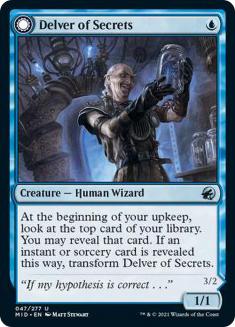



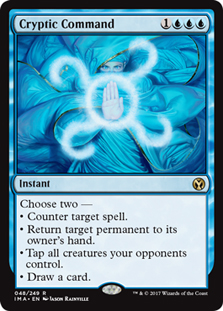
In:
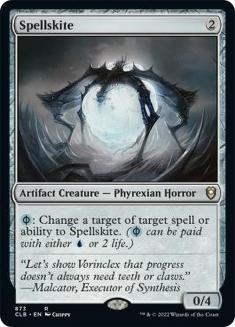

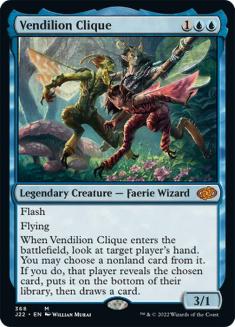

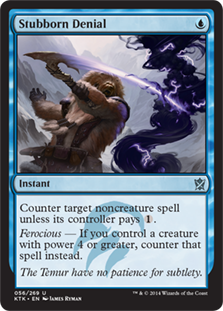
We’re cutting Delver of Secrets because the likelihood that we’ll actually “go under them” is effectively zero, actually getting Delver to work on time likely requires paying two more life than we want to in the early turns of the game… and worse yet, Delver actually gives Burn a profitable way to use Searing Blaze against us. We’re actually really well set-up to face this matchup, because large Tarmogoyfs + ways to stop small attackers / ways to counteract their best burn spells is actually really tough for them. Tarmogoyf + Spellskite is basically a hard lock, and while it may sound paradoxical to cut Delvers because they can get Searing Blazed and then add Vendilion Cliques, it’s not like we have zero targets – we just want to have zero good ones. Snapcaster Mages and Vendilion Cliques contribute to the overall plan of not getting killed by their burn spells, and should be worth somewhere near the neighborhood of a card before we potentially expose ourselves to a nasty two-for-one.
A key thing to note here is that the games we win here we’ll tend to win from between two and five life – and that’s accounting for the fact that we fetch only basics. Fetch one nonbasic and your cushion disappears, so if it’s game one and you’re on the play, if you don’t have an immediate great use for a Mishra’s Bauble like pairing it with a turn-one Delver, looking at your opponent’s top card might just save you a game you’d lose by fetching wrong. If you don’t respect Burn, you’ll lose the little bits of percentage you need to turn a loss into a win.
VS U/R Twin
Out (on the play):
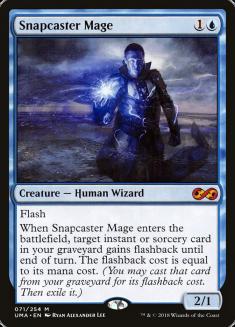
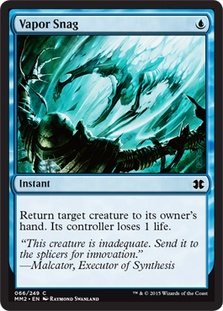

In (on the play):



Out (on the draw):





In (on the draw):





This one sounds a bit complicated, because by the looks of things, Spellskite in the sideboard is “there” for this matchup. In actuality, however, we’re already quite strong against them – Splinter Twin decks don’t like Abrupt Decay, and they definitely don’t like Abrupt Decay out of aggressive decks, plus all of our countermeasures are one-mana plays when the things they need to land cost way more than that. The big question comes down to this: will we be able to get under their defenses with a Delver, and how much of the combo will they still have in place to try and beat us versus how well will that work out for them in the first place? On the play, our Delvers will still be great, but on the draw they probably won’t be good enough – and likewise our vulnerability to them trying to keep in the combo and just jam it is much greater on the draw than on the play, making it worthwhile to keep in cards like Vapor Snag instead of cards like Cryptic Command.
The most relevant trick here is to be proactive but have some defenses up anyway, whether that’s by using discard to clear the way and see where we stand or by holding up mana to potentially spend on removal. Abrupt Decay becomes much better when our creature threat is Vendilion Clique, for example, and because we can do an awful lot with one mana (counter Splinter Twin, kill or bounce their creature) it’s a great idea to keep an uncracked fetchland open if we’re going to tap down low before passing the turn. We’re ahead against the combo and still in a solid position against the quasi-control shell they’ll probably find themselves forced to sideboard into, but in both cases watch out for Blood Moon and fetch basics proactively where possible.
VS G/R Tron
Some of our cards line up very badly here, and there’s not much we can do about that fact. Abrupt Decay and Inquisition of Kozilek are great against the format because the format is constrained to the low mana costs you can pay on early-game cards, and Tron is designed to turn that on its ear. We’re a decent beatdown deck against them, but some of our removal and discard will just be very sad and there isn’t enough stuff we’d want in our sideboard to take enough of it out.
Out:
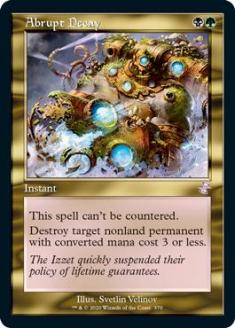



In:



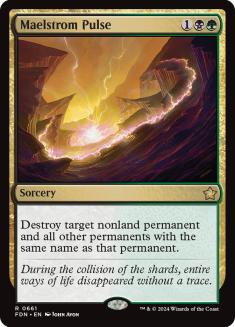
As far as blind spots are concerned, I’m entirely fine with this being ours; you can still Inquisition their Expedition Map or Sylvan Scrying away and leave them unable to do anything while you beat them down fast, and Stubborn Denial is very, very good against their overall plans. But we’re not designed to fight against a Wurmcoil Engine and shouldn’t really even try, and sometimes they just draw natural Tron and everything they want.
VS Affinity
Out:
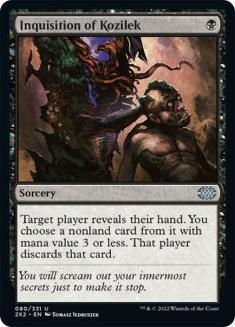




In:
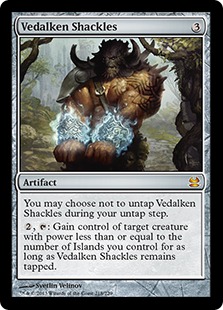

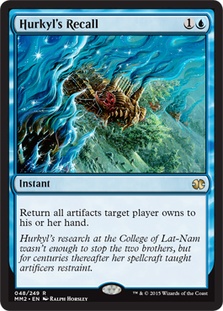

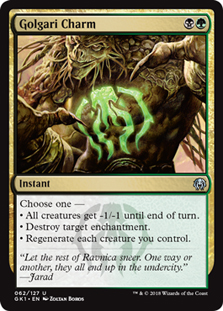
Golgari Charm was picked as a strong answer with versatility against Lingering Souls decks, and that versatility shows here: Affinity has tons of 0/1 or 1/1 creatures so sometimes this will just get a whole bunch of cards out of the way really fast. Spellskite might be okay – it blocks Etched Champion and can steal Ravager’s modular counters – but I’d really need to see something like Ensoul Artifact out of them before thinking it did enough things to warrant the slot. Mostly we lose by being stuck with too many dead draws when we just need to have creature removal and board control elements, and the first Inquisition is always good while the first Stubborn Denial may be junk. We can handle Platings and our Shackles even handle Etched Champions, so mostly we’re just trying to control the board long enough to connect for lethal… Hurkyl’s Recall is absolutely brutal in that regard, and that’s even before you Snapcaster it. Affinity seems to have fallen out of favor, so you could potentially shift those two slots over to help in other matchups, but I prefer to respect commonly-played decks that we definitely need help from our sideboard to improve against.
VS Abzan
We need to distinguish whether we’re playing against a Collected Company deck or just the traditional “Good Stuff” deck of removal, disruption, Lingering Souls and Siege Rhino – Stubborn Denial is not as good against the creature-heavy Company decks, and those tend to be very light on removal as well, so even though we’re putting in the same cards we’ll nonetheless sideboard very differently against them.
Out (versus Collected Company):





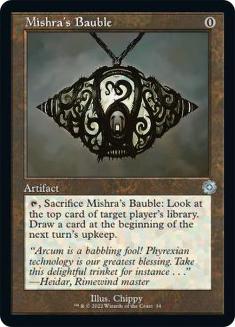
Out (versus Abzan Good Stuff):






In:
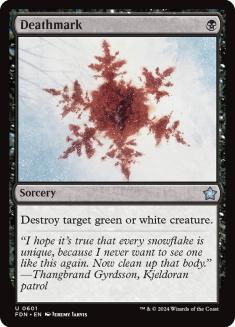





Against the grindier Abzan deck we’re more traditionally familiar with, we’re using Vedalken Shackles as one more way to grind against their Lingering Souls draws and we just want to draw more removal and threats – topdecking fights happen regularly here, so any Inquisition of Kozilek drawn past our opening grip is going to be the kind of dead draw that costs us the game. We have – and need – far fewer lands than they do, so we’ll have more live draws to go with our much-greater card selection, and we’ll generally fall into the beatdown role and want Delvers to pressure their copies of Abrupt Decay and Path to Exile anyway as there are much juicier targets for either. Against Collected Company decks we need to break up specific combos and Inquisition hits pretty much anything but the Company itself, so even though they’re dead later on they’re so much better in this context than against the “bigger” Abzan decks that grind harder. Delver of Secrets is also less likely to be critical – we fall into the control role here, and are more likely to need a small tempo effect like Vapor Snag to break things up when Collected Company resolves.
VS Living End
Out:



In:



They’re pretty far behind us and really need to get a Living End to even stay alive, and we’re very good at making sure they don’t get to do exactly that – either by discarding the Cascade card or countering the spell itself. Abrupt Decay does nothing and so long as you’re careful you can usually find a good time to sneak in a Clique, just remember that Violent Outburst is an instant and you can’t just jam Clique at end of turn and expect things to work for the best. So long as you’re smart, this is a decent matchup… though I haven’t tested against the variant with Splinter Twin in it, I don’t think it should shift things too considerably, they need something to go with Deceiver Exarch and Vapor Snag is just as good at breaking up that combo as Abrupt Decay would be while potentially doing a trick with your own Snapcaster Mage or getting in a relevant point of damage. Surgical Extraction would be going too deep here, since we need to focus on making sure Living End doesn’t happen, not mitigating what might go wrong if it does happen.
VS Scapeshift
Like G/R Tron, this is a matchup where the focus of our cards just doesn’t really work out so well; unlike G/R Tron, we start by having a good matchup and get better after sideboarding.
Out:



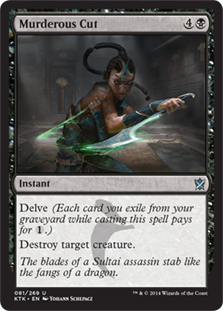

In:
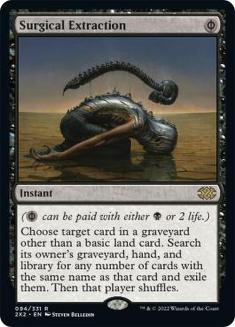




Surgical Extraction is worth pulling the trigger on for Remands, they aren’t here to get the second through fourth Scapeshifts after you’ve successfully countered the first. Successfully countering the first Scapeshift is probably the entire game right there, but you need to present a reasonable clock so they don’t have enough time to start getting fancy or even just to dig for their namesake card. We start ahead, we stay ahead, and the Surgicals only come in because at least they’re not dead creature removal cards – and sometimes you’ll get to see what the right Surgical target is thanks to Inquisition of Kozilek, like seeing they drew two copies of the same fetchland and being able to “get ’em” in a way they didn’t expect.
VS Infect
Out:





In:





Infect can’t beat a Spellskite, just like Burn basically can’t, and that is why Spellskite is in our sideboard; it’s merely good against Twin by comparison, and that’s already a good matchup, but neither of these are fun matchups to start with and both basically fold to a Spellskite sitting in play. They have a real hard time beating a Shackles either, but watch out for the fact that some of our removal can line up badly against them – Abrupt Decay can’t kill an Inkmoth Nexus, and they have effective “countermagic” for our removal via Apostle’s Blessing and Vines of the Vastwood.
VS Grixis Delver
Out (on the play):



In (on the play):



Out (on the draw):






In (on the draw):






We’re both trying to do the same thing here, but here’s the advantage: they have to try and line up Lightning Bolt against our Tarmogoyfs while we get to line up Abrupt Decay against pretty much anything but Tasigur – and our Goyfs should be bigger than Tasigur to boot. There is some tension here – they could try and surprise us with Blood Moon, which makes us want basic lands, but we want to fetch our nonbasics to power up Shackles – but our removal lines up better against their threats than the other way around, and some of that removal even wins the control fight that happens in the middle stages of the game. We’ll miss Remands here a little because those are very good against Tasigur, but that’s what Vapor Snag and the rest of the non-Decay removal is here to handle… and we get access to more of it after sideboarding if we can build our Shackles up big enough to steal a Tasigur.
VS Amulet Bloom
I can’t tell straight-up whether I’m beating this because it’s a good matchup or if I’m beating this because my opponents are bad at playing it, and recent events have just made that all the more confusing for me – it did well at the Season Two Invitational, but prior to that there was a kerfluffle effectively invalidating one of the deck’s recent wins, so it’s hard to be sure whether this deck is good or just powerful. I think it’s a reasonable matchup, but also we basically can’t counter a Primeval Titan and half our removal can’t kill it, so I’m entirely open to the possibility that my strong results have been a small-sample-size issue. They don’t like Inquisition and Stubborn Denial and we can actually kill an Amulet once it’s in play, so at least on paper this seems like a reasonable matchup – but sometimes you die on turn one or turn two and no one could’ve done anything about that besides check to make sure your opponent presented a sixty-card deck rather than 53.
Out:



In:



Worrying about being able to stop a Primeval Titan seems like the wrong thing to stress over when you can work to prevent them from having the mana to cast it in the first place. So do that – just be aware that a turn-one Delver might be wrong, either on the play or the draw, if you could have kept open Stubborn Denial instead. I’m one of the whole host of people who haven’t tested thoroughly enough against this deck to have caught any nuances to it yet, and it’s probable that Spellskite is good against them too – their best hands just make fast Primeval Titans and search up lands that target the Titan, and Spellskite messes those plans up considerably.
VS Jeskai Control
Out:



In:



We have this deck pretty dead-to-rights to begin with, and we’re just shifting around our underwhelming cards for things that help us pick, and win, a control battle. Our Delvers are very likely to die, but in dying they serve a useful function, so we want to keep being the beatdown rather than worry about the fact that they’re sure to have an answer – their answers leave us more windows to resolve further spells, and we just want to jam more threats till the last one sticks.
VS Storm
Out (on the play):




In (on the play):




Dead cards become live ones; our basic plan doesn’t need to change.
Out (on the draw):





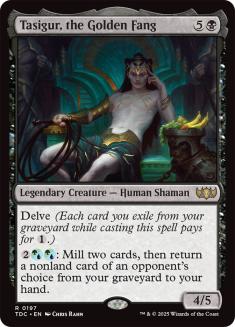
In (on the draw):






The matchup is very different based on whether we’re on the play or on the draw – on the play we can just jam a Delver on our first turn and not have to worry about them doing anything we care about, while on the draw that’ll just leave them a window to cast a Pyromancer’s Ascension that we might otherwise have the Stubborn Denial for. To win the match you’ll need to win on the draw at least once, so recognizing they can do very dangerous things as early as turn two is key – we can’t just tap out willy-nilly unless we’ve Inquisitioned them first, so our overall gameplan likely gets much slower. Surgical Extraction is an unpleasant surprise for them insofar as we can do stuff while seeming to be tapped out, making their Past in Flames harder to turn into a win, while Golgari Charm at least does something compared to the basically-nothing of the card we’re cutting for it – giving us an out to Empty the Warrens, in case that is a thing, and standing in as a fourth copy of Abrupt Decay against Pyromancer’s Ascension even though it can’t kill a Goblin Electromancer.
Surgical-Snapaster Mage for the re-buy is very strong here, but what usually gets them is Inquistion-Tarmogoyf-Snapcaster on the Inquisition. And sometimes they just do nothing, or rely too hard on a Pyromancer’s Ascension that you can actually remove from play. There’s a lot of play here, but we’re fighting on their level thanks to having an incredibly high level of impact per point of mana spent by our deck.
If there are any other matchups of interest to you here, sound off and I’ll happily chime in with my experiences against that deck (if I have any – Modern is a big format). I think this is a strong argument for “best version of the Delver deck everyone has been working on lately,” as well as a strong natural end-point for Patrick Chapin’s explorations with Gurmag Angler in recent months… and I’d be surprised if it didn’t throw a monkey-wrench into Grand Prix Charlotte!

